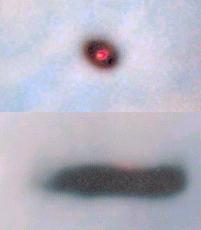
| Home Page | Overview | Site Map | Index | Appendix | Illustration | FAQ | About | Contact |
 |
It is very difficult to observe planets outside the solar system because they can be seen only by the reflecting light. It is just too dim and too far away to be detected by the telescope. Recently, its presence has been deduced from the small perturbation on the movement of the central star, and HST (Hubble Space Telescope) was able to obtain pictures on the newborn planetary systems in the Orion Nebula as shown in Figure 07-01a. The photo on top shows a newborn star (the red dot) surrounded by dark, dusty disk of orbiting gas. The bottom photo shows the edge-on view of another star forming region. Some five billion years ago the solar system probably looked similar. Then, over the course of a few hundred million years, the dusty material clumped into the nine planets orbiting the Sun today. |
Figure 07-01a Birth of Planetary System |
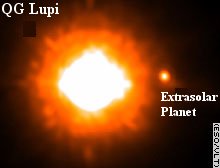 |
In the spring of 2005, an image of an extrasolar planet was finally captured by the combined effort of VLT, HST, and the Subaru Telescope (see Figure 07-01b). The mass of the planet is about two times that of Jupiter. It is about 100 times farther from the young star GQ Lupi than Earth is from the Sun. The star GQ Lupi is part of a star-forming region about 400 light-years away. It is about 1 million years old with 70% the mass of the Sun. The planet is only 156 times fainter than the star, because it is still very young and hence still forming, still contracting with a temperature of about 3000oF. This system resembles in some respects our own solar system in its formation years. Despite the observational difficulties, astronomers have found about 150 extrasolar planets over |
Figure 07-01b Extrasolar Planet |
the past decade. It seems to indicate that formation of planetary system is a rather common phenomena. |
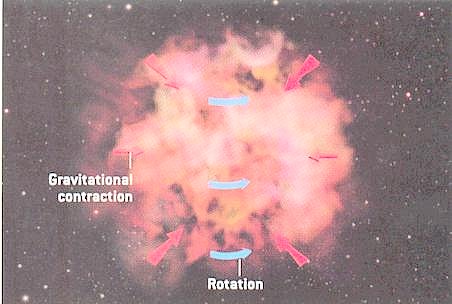 |
 |
 |
The solar system, it is thought, began as a subcondensation in an interstellar cloud of gas and dust, from which probably hundreds of other stars also formed. To begin with, this presolar cloud was spheroidal, slowly rotating, and quite large, with a diameter of perhaps one |
Figure 07-02a Disk Formation 1 [view large image] |
Figure 07-02b Disk Formation 2 [view large image] |
Figure 07-02c Disk Formation 3 [view large image] |
or two light-years (Figure 07-02a). As it con- densed, the gas in the cloud's equatorial plane moves inward more slowly because its rotation starts to balance the gravity, causing it to |
The gas and dust in the protoplanetary disk formed small bodies between 1-10 km in diameter. These bodies are known as planetesimals. Initially they formed small fragments of solar dust up to about 1 cm in diameter by the processes of cohesion (sticking together by weak electrostatic forces) and by gravitational instability. Larger bodies formed later by collisions at low speed which caused the material to stick together by gravitational attraction. Support for this view of the process of accretion comes from a region on the edge of the solar system known as the Kuiper Belt, where it is thought that the accretive 'mopping up' had failed to complete and the raw materials are still around as comets. The final stage of accretion has been described as 'runaway accretion'. Planetesimals were swept up into well defined zones around the sun close to the present orbits of the terrestrial planets. The process led eventually to a small number of large planetary bodies. Evidence for this impacting process can be seen in the early impact craters found on planetary surfaces.
Two key factors determine what kind of planet a protoplanet will become: its mass and its distance from the central star. Planets of low mass cannot retain hydrogen and helium, the lightest and most abundant gases, especially if their temperature rises to the point at which the lightest molecules escape. When the planets were in their early accretive phase, the mass that agglomerated before the Sun began to shine helped determine how well the planet could retain its hydrogen and helium. The other crucial factor, the distance of the planet from the Sun, also influenced the escape of hydrogen and helium from the planet's gravity, because inner planets become hotter and so have more difficulty in retaining the lightest gases with a given amount of gravitational force. These considerations explain well the overall structure of the solar system. The four small, inner planets were unable to hold on to any free hydrogen and helium with which they may have started out. However, the four gas giants, lying much further out from the Sun and therefore having much lower temperatures, not only retained their light gases but, through their powerful gravitational pulls, continued to draw in more material after the Sun had turned on.
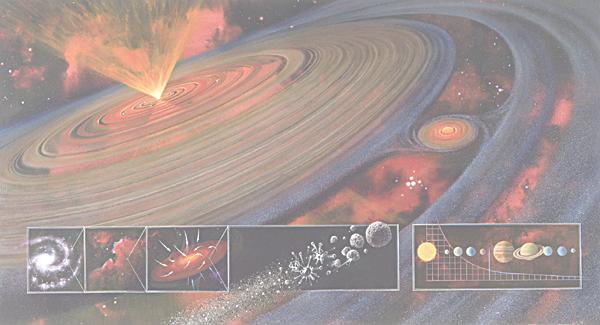 |
Figure 07-02d is an artist's conception of the formation of a planetary system. The first three lower inset boxes zoom in from the spiral arm of the Milky Way to a star-forming region such as Orion, and then to a newly-forming star with its gas disk. The upper picture shows that the disk has become thin and is beginning to break into rings of gas and dust. The dust rings will condense into rocky "planetesimals" that will eventually merge to become planets, as shown in the inset at the lower right. Jets of gas flow out from the newborn star in the polar directions. |
Figure 07-02d Formation of Planetary System | [view large image] |
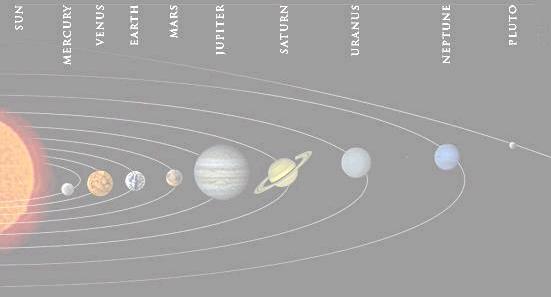 |
Figure 07-03 is a schematic diagram of the nine planets (distance and size not drawn to scale). Table 07-01 below is a fact sheet about these planets and other planetary objects in ascending distance from the Sun, where Me = Mass of the Earth = 6x1027 gm. De = Diameter of the Earth = 1.3x109 cm. Distance from Sun to Earth = 1 AU = 1.5x1013 cm. |
Figure 07-03 Solar System |
| Object | Mass (Me) | Size (De) | Distance (AU) | Rotation (Day) | Revolution (Year) | Satellite (#) | Surface Temp. (oC) | Density (H2O) | Atmospheric Composition |
|---|---|---|---|---|---|---|---|---|---|
| Sun | 3x105 | 100 | 0 | 25.38 | +5500 | 1.4 | H2 91%, He 9% | ||
| Mercury | 0.06 | 0.38 | 0.39 | 58 | 0.24 | 0 | +350(day), -170(night) |
5.4 | O2 42%, N2 29%, H2 22% |
| Venus | 0.82 | 0.95 | 0.72 | 243 | 0.62 | 0 | +475 | 5.3 | CO2 96%, N24% |
| Earth | 1.00 | 1.00 | 1.00 | 1.00 | 1.00 | 1 | +22 | 5.5 | N2 78%, O2 21% |
| Moon | 0.012 | 0.27 | 1.00 | 27.32 | 1.00 | +127 (day) -173 (night) |
3.3 | He, Ne, H2, Ar | |
| Mars | 0.11 | 0.53 | 1.52 | 1.00 | 1.88 | 2 | -23 | 3.9 | CO2 95%,N2 3% |
| Asteroid | < 10-4 | < .07 | ~ 2.7 | < 17 | 1 - 50 | 2.7 | |||
| Jupiter | 318 | 11.2 | 5.20 | 0.4 | 11.86 | 16 | -123 | 1.3 | H2 90%, He 10% |
| Saturn | 95 | 9.4 | 9.54 | 0.4 | 29.46 | >18 | -180 | 0.7 | H2 97%, He 3% |
| Uranus | 15 | 3.9 | 19.2 | 0.7 | 84.0 | >16 | -218 | 1.3 | H2 83%, He 15% |
| Neptune | 17 | 3.8 | 30.1 | 0.7 | 164.8 | 8 | -228 | 1.6 | H2 85%, He 13% |
| Pluto | 0.002 | 0.2 | 39.5 | 6.4 | 248 | 1 | -230 | 2.1 | CH4, N2 |
| Comet | ~ 10-12 | ~ 10-4 | 30 - 5x104 | 3 - 4x104 | 0.25 |
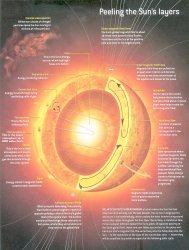 |
All the solar energies are produced at the core within a zone from the center to about 20% of the solar radius, where the density increases to about 160 times the density of water and the temperature reaches 15 million oK. The energetic photons lose energy as they diffuse outward in the radiative zone, which occupies about 50% of the solar radius. The energy is then transported by means of convection out to the photosphere where the radiation becomes mostly visible light. Data for the Surface Temperature and Atmospheric Composition of the Sun in Table 07-01 are referred to the photosphere, which is the visible surface radiating the continuous spectrum. The atmosphere consists of an inner layer called chromosphere and an outer layer called corona where the gaseous density becomes more tenuous but the temperature increases to more than one million degree K and radiates mainly at extreme ultraviolet and x-ray wavelengths. Figure 07-04 shows the structure of the Sun in details. |
Figure 07-04 The Sun [view large image] |
 |
The terrestrial (inner) planets are composed mostly of rock and metal. As shown in Figure 07-05, Earth is the largest of the inner planets, followed by Venus, Mars, Mercury and the Moon. The interior of the Earth consists of an Fe-Ni core below a mantle of silicate rock. A comparison shows that Venus and Mars have a comparatively similar rock-iron distribution. The Moon has a much smaller core, whereas Mercury, although it is small enough to fit in the Earth's core, has a relatively large iron core. Mercury and the Moon have a large surface temperature variation between night and day. It is the result of these objects' small mass, which can barely retain a thin atmosphere. The Moon is the only celestial object that has been visited by human. |
Figure 07-05 The Terrestrial Planets | [view large image] |
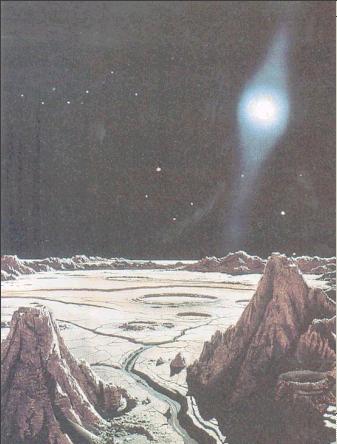 |
|
Figure 07-06 |
Mercury [view large image] |
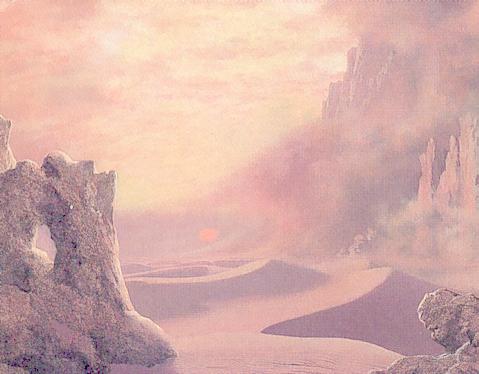 |
The "greenhouse effect" maintains a sizzling surface temperature of 480oC over the whole planet, with very little difference between day and night. Details of the surface have been hidden under the clouds until radar-mapping satellites were placed in orbit around the planet. From 1990 to 1994 the Magellan space probe mapped the entire surface of Venus at high resolution by peering through the clouds with radar. It revealed a planet that has experienced massive volcanic eruptions in the past and is almost surely active today, and there is a vast system of highlands and ridges running across much of the equator (see Figure 07-07). |
Figure 07-07 Venus' Surface |
 |
Earth was struck by a massive body, possibly as massive as the planet Mars, shortly after its formation. The Moon was formed by accumulating the orbiting debris through much the same processes as the planets themselves. According to data collected by the Apollo and other Lunar missions, the most favored hypothesis is the impact theory, which accounts for the lower proportions of iron and volatiles in the lunar rocks. If the impacting body had been moving in or close to the ecliptic plane (as the other planets do), the debris would have ended up orbiting the proto-Earth close to that plane, thereby accounting for the significant tilt of the Moon's orbit relative to the plane to the Earth's equator. The impact may also have been responsible for inducing the tilt in the Earth's rotational axis. [view large image] |
Figure 07-08 New Moon |
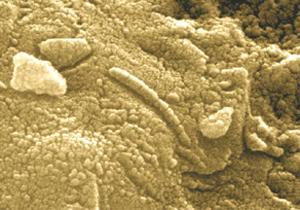 |
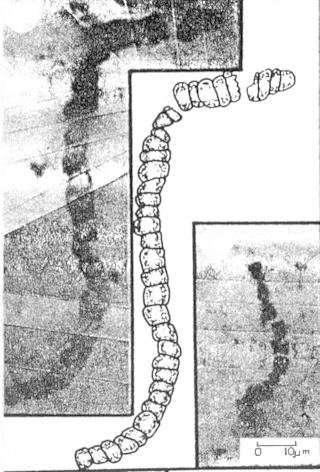 |
life may have existed on Mars in the past received a boost in 1996 with the tentative identification of nanofossils (with a size up to 2 x 10-2 cm) in the Martian meteorite ALH84001 (Figure 07-09a), which consists of rocks that are 4.5 billion years old. It may have subsequently been permeated by water about 3.6 billion years ago. These time scales coincide closely with the formation of the Earth and the origin of life on Earth. Figure 07-09b shows fossil imprints of filamentous bacteria (with a size of several 10-2 cm), whose cells have been preserved between layers of sedimentary rocks |
Figure 07-09a Life on Mars |
Figure 07-09b Bacteria on Earth [view large image] |
3.465 billion years old in north western Australia. The similarity between the two samples is remarkable. |
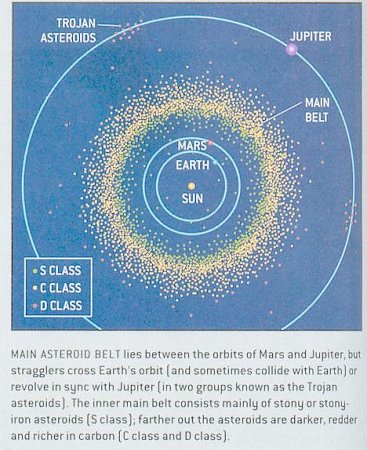 |
Asteroids are rocky and metallic objects that orbit the Sun but are too small to be considered planets. They are known as minor planets. Although it seems to be a very dense belt in the schematic diagram of Figure 07-10, spacecraft that have flown through this zone have found that it is really quite empty and that asteroids are separated by very large distances. Asteroids range in size from Ceres, which has a diameter of about 1000 km, down to the size of pebbles. Sixteen asteroids have a diameter of 240 km or greater. They have been found inside Earth's orbit to beyond Saturn's orbit. Most, however, are contained within a main belt that exists between the orbits of Mars and Jupiter. Some have orbits that cross Earth's path and some have even hit the Earth in times past. One of the best preserved examples is the Barringer Meteor Crater near Winslow, Arizona. |
Figure 07-10 The Asteroid Belt | [view large image] |
|
Asteroids are material left over from the formation of the solar system. One theory suggests that they are the remains of a planet that was destroyed in a massive collision long ago. More likely, asteroids are material that never coalesced into a planet. In fact, if the estimated total mass of all asteroids was gathered into a single object, the object would be less than 1,500 kilometers across -- less than half the diameter of our Moon.
Much of our understanding about asteroids comes from examining pieces of space debris that fall to the surface of | the Earth. Asteroids that are on a collision course with the Earth are called meteoroids. When a meteoroid strikes our atmosphere at high velocity, friction causes this chunk of space matter to incinerate in a streak of light known as a meteor. If the meteoroid does not burn up completely, what's left strikes Earth's surface and is called a meteorite. Of all the meteorites examined, 92.8 percent are composed of silicate (stone), and 5.7 percent are composed of iron and nickel; the rest are a mixture of the three materials. Stony meteorites are the hardest to identify since they look very much like terrestrial rocks. |
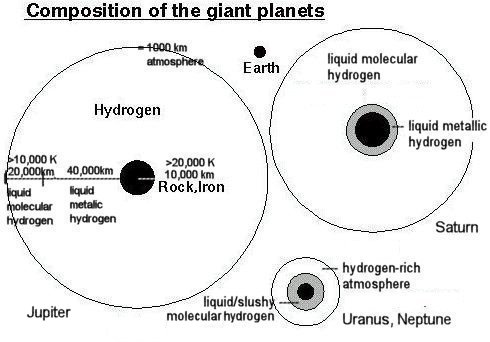 |
As shown in Figure 07-11, the giant outer planets consist mostly of hydrogen and helium gas and liquid, which surrounds a core of iron and rock and possibly a smaller amount of methane, carbondioxide and water ices. Jupiter is the largest planet, closely followed by Saturn. Uranus and Neptune are in comparison much smaller, although still significantly larger than any of the terrestrial planets. Jupiter is a "failed star" - it would have become a star igniting nuclear fusion at its core if its mass is about 80 times higher (the lowest mass limit for a star to form is about 0.05 MSun). |
Figure 07-11 The Jovian Planets | [view large image] |
 |
Figure 07-11. It has a powerful magnetic field (more than ten times than the Earth's) generated by circulating liquid metallic hydrogen instead of molten iron. Jupiter's disc displays parallel bands of cloud (due to its rapid rotation) with continually changing detailed structure. The only really long-lived feature is the Great Red Spot, a rotating weather system measuring some 25,000 km by 12,000 km, which has been lasted for over three centuries. Jupiter is surrounded by an exceedingly faint system of rings and a family of 16 satellites. |
Figure 07-12 The Galilean Moons [view large image] |
 |
Io is the nearest moon to Jupiter. It is subjected to tremendous tidal force from Jupiter and the three other moons outside. Incessant volcanic activities have turned the materials inside out many times. The surface is pockmarked with craters and lava. The colorful image is produced by sulfur, which takes on various hue at different temperatures (see Figure 07-13). Jupiter's magnetic fields interact with Io's ionized gases from volcanic eruptions. It creates a torus of plasma carrying an electric current of five million amperes (see Figure 07-12). [view large image] |
Figure 07-13 Io |
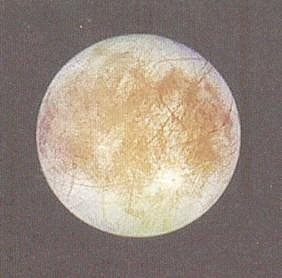 |
The effect of the tidal force on the second nearest moon Europa is not as severe. However, it has melted the water under the ice shell. Europa's icy countenance resembles a cracked eggshell (see Figure 07-14). Reddish material has oozed out of fractures opened up by Jupiter's gravitational forces. It is thought that the subsurface ocean might harbor life. Although only a theory, this scenario is bolstered by the discovery of life-forms on the Earth's ocean floor that exist in total blackness, sustained entirely by chemical rather solar energy. Bizarre tube worms, crabs, clams and other animals and plants live around warm-water vents in deep-sea midocean rifts, relying on the sulfur and oxygen in the mineral-rich water for the energy required to support them. |
Figure 07-14 Europa |
In a sequel to the novel 2001: A Space Odyssey - 2010: Odyssey Two, there is a passage about the destruction of a Chinese spaceship landed on Europa. While it was pumping water from the "canal", its floodlights induced a fatal attraction of a phototropic creature. ... |
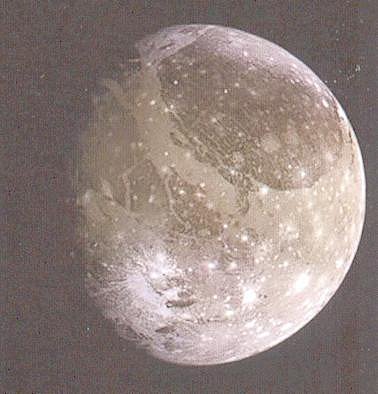 |
Ganymede is the largest moon in the solar system (slightly larger than Mercury). It is a cratered world with a mainly water-ice surface darkened by dirt (see Figure 07-15). Some of the impacting comets and asteroids punched through the light brown soil-ice surface composite and exposed brighter, cleaner ice underneath. But Ganymede has more than just craters. Large areas of ribbed and ridged icy material are spread like continents over the satellite. These regions, which look like glacial flows on Earth, have fewer craters than other sectors and are clearly younger.
[view large image] |
Figure 07-15 Ganymede |
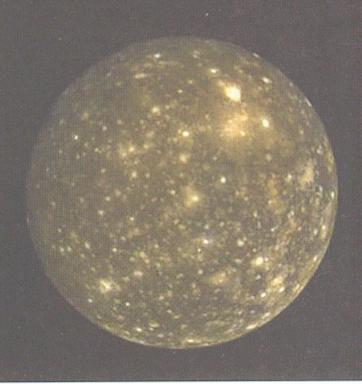 |
Callisto is the outermost the Galilean moons and the only one far enough from Jupiter's intense radiation belts to be a possible landing site for Earth explorers unprotected by shielding. It is one of the most heavily cratered object in the solar system (see Figure 07-16). The crater-scarred surface of Callisto appears much as it must have looked four billion years ago, soon after the solar system formed. Callisto's rock is primarily water ice with lunar-like dirt mixed in. At the surface temperature of -145oC, water ice acquires the stiffness of rock, rather than the more plastic characteristics of glaciers on Earth.
[view large image] |
Figure 07-16 Callisto |
 |
period than Jupiter, it bulges more markedly at the equator (see Figure 07-17a). Saturn's composition and internal structure are believed to be broadly similar to those of Jupiter, but its cloud belts and weather systems are much more muted in appearance than are those of Jupiter. Saturn's most distinctive feature is its system of rings. The rings are composed of billions of individual particles of ice and ice-coated rock, ranging in size from 1 cm to tens of meters. Other objects around Saturn are the 18 satellites with diameters ranging from 20 km to Titan's 5150 km (larger than Mercury). The satellites are believed to be composed of mixtures of rock and ice. |
Figure 07-17a Saturn & Titan [view large image] |
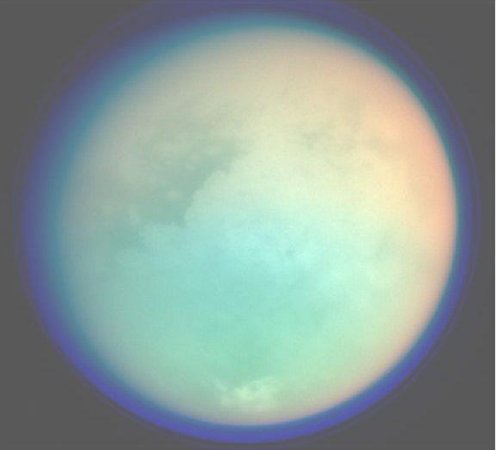 |
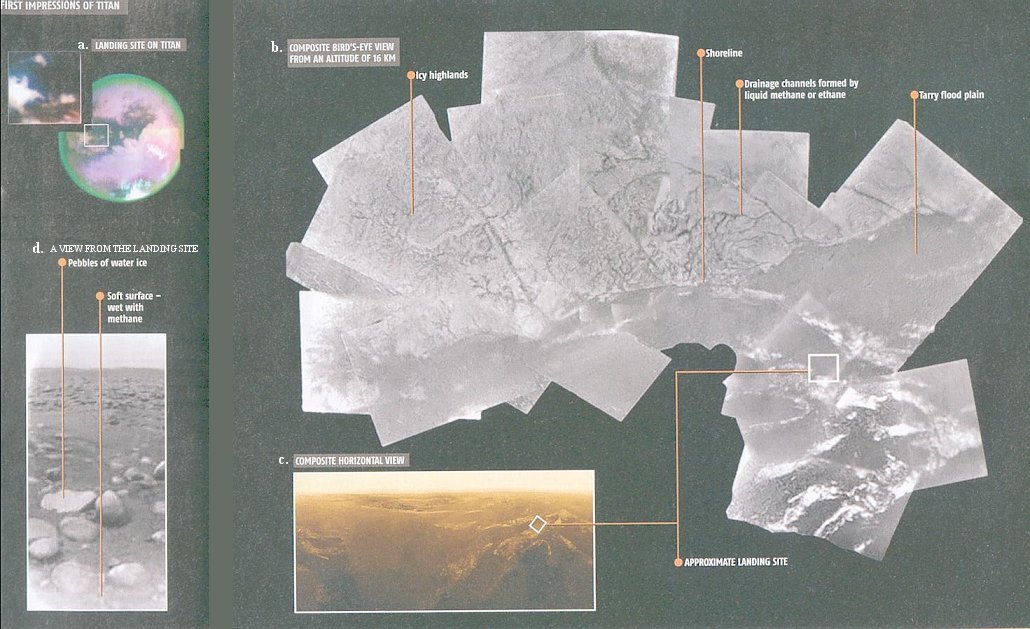 |
Titan's atmospheric methane while bright and dark surface areas are revealed in a more penetrating infrared band. Ultraviolet data showing the extensive upper atmosphere and haze layers is seen as blue. Sprawling across the 5,000 kilometer wide moon, the bright continent-sized feature known as Xanadu is near picture center, bordered at the left by contrasting dark terrain. Saturn orbiter Cassini and Titan lander Huygens plan |
Figure 07-17b Titan |
Figure 07-17c Titan Surface |
further explorations, but for now the origin and nature of Titan's surface features remain unknown. |
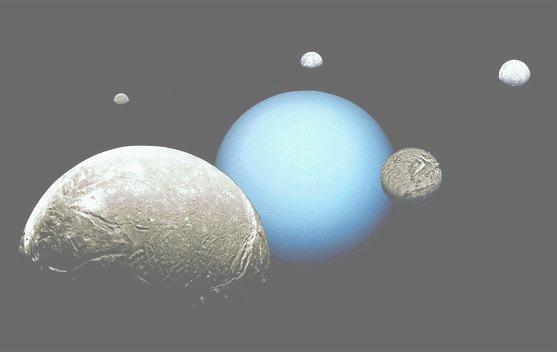 |
lies almost in the plane of its orbit. Therefore, it has a most peculiar pattern of seasons, with each pole experiencing about 42 years of continuous sunlight followed by similar period of darkness. Uranus is surrounded by a system of at least ten narrow dark rings revolving at the same kind of tilted axis). The individual rings are composed primarily of meter-size lumps of material that are as dark as coal. The planet has sixteen or more satellites, which also revolve around Uranus' tilted equatorial plane. Some of these satellites are shown in Figure 07-18. |
Figure 07-18 Uranus and its Moons |
[view large image] |
 |
One of the satellites is Triton, which was studied in detail by Voyager and proved to be a fascinating world. It is a highly reflective body and it is also the coldest body with a surface temperature of -236oC. Its icy surface has an intriguing variety of terrain, and its polar cap, composed of frozen nitrogen, is streaked with dark material deposited from plumes of nitrogen ice, gas, and hydrocarbon-rich material ejected by erupting "geysers" that burst through the icy crust. Unique among major planetary satellites, Triton revolves around Neptune in a retrograde direction (opposite to the direction of the planet's rotation). It is gradually spiral in toward the planet, so that, in |
Figure 07-19 Neptune & Triton |
about a hundred million years' time, it will either collide with Neptune or be torn apart by gravitational tidal forces and scattered around the planet to form a spectacular ring system. |
 |
Pluto -- As shown in Figure 07-20, Pluto is really a double planet system, since its moon, Charon, is very close and about half of its size. There are some who think Pluto should be classified as a large asteroid or comet. Some consider it to be the largest of the Kuiper Belt (Trans-Neptune) objects. Unlike the other planets, Pluto's orbit is highly eccentric; it has an inclination angle of 17o; and the spin axis has a tilt of 120o relative to the ecliptic plane. Pluto's atmosphere is extremely tenuous. It may exist as gas only when Pluto is near its perihelion (the nearest approach to the Sun), where it is likely that some of the atmosphere escapes to space perhaps even interacting with Charon. For the majority of Pluto's long year, the atmospheric gases are frozen into ice. |
Figure 07-20 Pluto [view large image] |
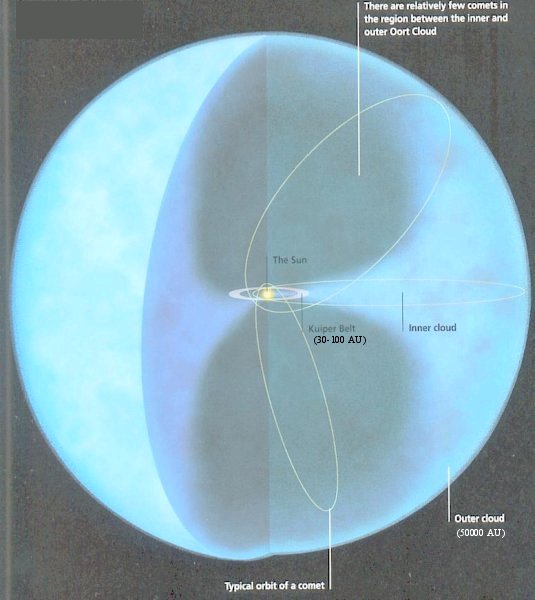 |
Comets are formed of rocky material, dust, and water ice. A few have highly elliptical orbits that bring them very close to the sun and swing them deep into space, often beyond the orbit of Pluto. The most widely accepted theory of the origin of comets is that there is a huge cloud of comets called the Oort Cloud11 (see Figure 07-21a), of perhaps 1000 comets orbiting the sun at a distance of about 50,000 AU (in the Solar System halo). These comets are near the boundary between the gravitational forces of the sun and the gravitational forces of other stars with which the sun comes into interstellar proximity every several thousand years. Ac-cording to the theory, these stellar passing perturb the orbits of the comets within the Oort cloud. As a result, some may be captured by the passing star, some may be lost to interstellar space, and some of their orbits are modified from a relatively circular orbit to an extremely elliptical one coming close to the sun. These are the long period comets with period more than 200 years. |
Figure 07-21a Kuiper Belt and Oort Cloud [view large image] |
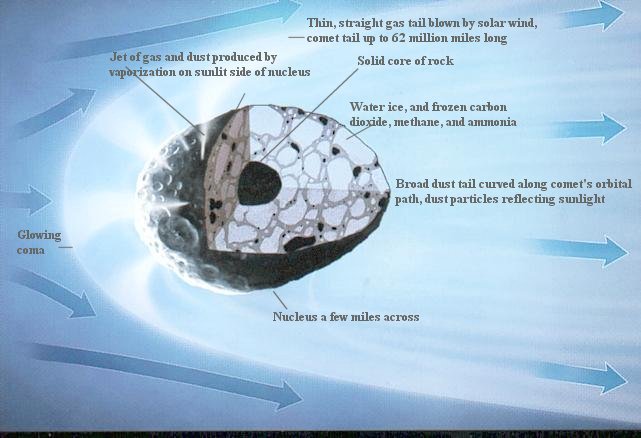 |
Another reservoir of comets is the Kuiper belt12 (see Figure 07-21a), a disk-shaped region about 30 to 100 AU from the sun beyond Neptune. This is considered to be the source of the short-period comets. The orbit of a Kuiper belt object is sometimes perturbed by gravitational interactions with the Jovian planets causing it to cross Neptune's orbit, where eventually it may have a close encounter with Neptune, either ejecting the comet or throwing it deeper into the solar system. These are the short period comets with period less than 200 years. |
Figure 07-21b Comet Structure [view large image] |
|
Comets are invisible until they come near the sun and develop an extended structure. These structures are diverse and very dynamic, but they all include a surrounding cloud of diffuse material, called a coma, that usually grows in size and brightness as the comet approaches the sun. The dense, inner coma often appears pointlike, but the actual nucleus is rarely seen from Earth because it is too small and dim. The coma and the nucleus together constitute the head of the comet. When far from the sun, the nucleus is very cold and its material is frozen solid. In this state the comets are sometimes referred to as "dirty icebergs" or "dirty snowballs," since over half of their material is ice. As the comets approach the sun they develop enormous tails of luminous material that extend for millions of kilometers from the head, away from the sun. Approaching within a few AU of the sun, the surface of the nucleus begins to warm, and the volatiles evaporate. The evaporated molecules boil off and carry small solid particles with them, forming the comet's coma of gas and dust. When a coma develops, dust reflects sunlight, while gas in the coma absorbs ultraviolet radiation and begins to fluoresce. At about 5 AU from the sun, fluore- | scence usually becomes more intense than the reflected light.
As the comet absorbs ultraviolet light, chemical processes release hydrogen, which escapes the comet's gravity and forms a hydrogen envelope. This envelope cannot be seen from Earth because its light is absorbed by the atmosphere, but it has been detected by spacecraft. The sun's radiation pressure and solar wind accelerate materials away from the comet's head at differing velocities according to the size and mass of the materials. Thus, relatively massive dust tails are accelerated slowly and tend to be curved. The ion tail is much less massive, and is accelerated so greatly that it appears as a nearly straight line extending away from the comet opposite the sun. The structure of a comet approaching the Sun is shown in Figure 07-21b. Each time a comet visits the sun, it loses some of its volatiles. Eventually, it becomes just another rocky mass in the solar system. For this reason, comets are said to be short-lived, on a cosmological time scale. Many believe that some asteroids are extinct comet nuclei, comets that have lost all of their volatiles. |
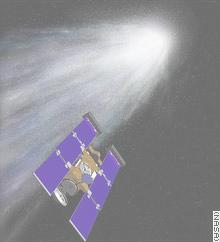 |
 |
by Stardust when passing within 500 kilometers. Clearly visible are numerous craters and hilly terrain. Stardust has also captured particles from the coma and will jettison them to Earth in 2006. Analyses of the images and returned particles will likely give fresh information about our Solar System back near its beginning, when Comet Wild 2 formed. Discovered in 1978, Comet Wild 2 takes 6.39 years to orbit the Sun, traveling nearly as close to the Sun as Mars is and as far away from the Sun as Jupiter. |
Figure 07-22a Stardust [view large image] |
Figure 07-22b Wild 2 |
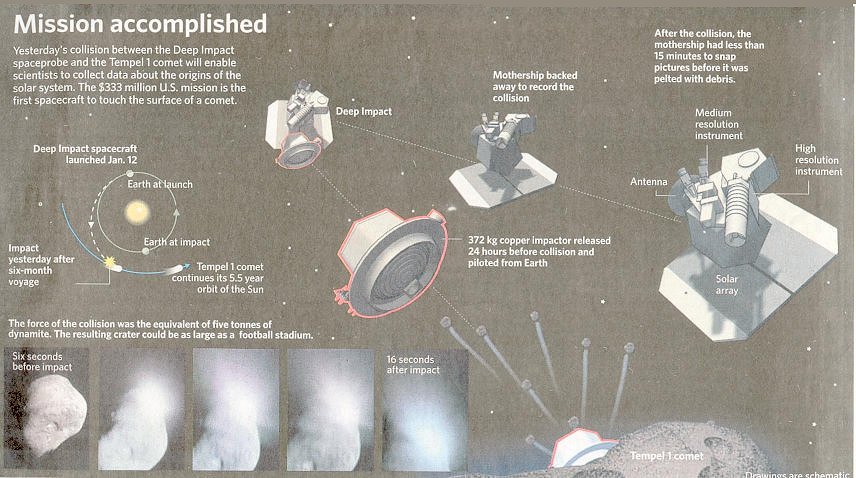 |
On July 4, 2005 NASA smashes a 372 kg spacecraft into the comet Tempel1 in the believe that the debris from under the comet's surface would reveal the composition of the solar system 4.5 billion years ago at the time of its formation. Figure 07-23 shows the hardwares for the mission and the sequence of events near the time of impact. Click here to see a movie showing the approach of the impactor (toward Tempel 1). Initial analysis indicates that the comet appears to have a soft, dusty surface with crater-like features. |
Figure 07-23 Tempel 1 Impact [view large image] |
Trapped ice seems to be below the surface, possibly containing the primordial ingredients of the solar system. Click here to see the impact as observed by the HST. |
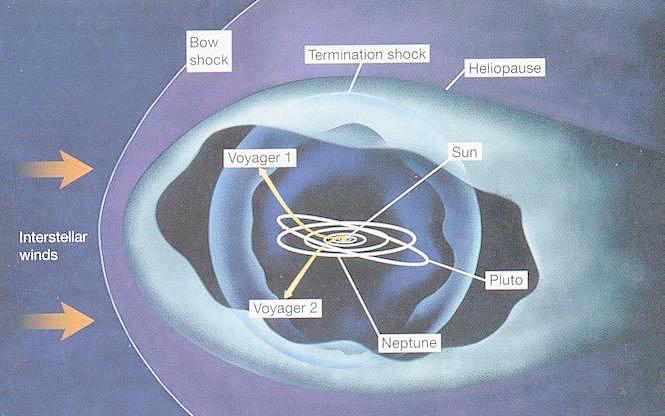 |
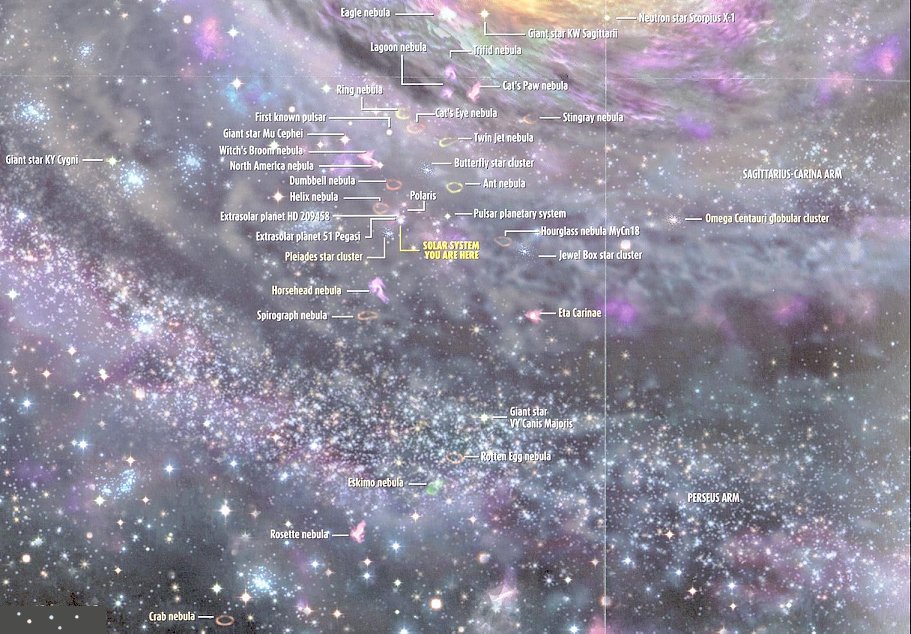 |
120 AU ( ~ 0.0015 ly), which is well within the radius of the Oort cloud. The Voyager 1 spacecraft is now crossing the boundary at a speed of about 20 km/sec. Further out still, if the Solar system is itself moving supersonically relative to the interstellar medium, there may be a large bow shock as shown in the illustration. Figure 07-25 shows some celestial objects in the spiral |
Figure 07-24 Solar Boundary [view large image] |
Figure 07-25 Solar Neighbor- hood [view large image] |
arms of the Milky Way within 6000 ly of the Sun. Table 07-02 lists a few of the prominent objects just beyond the solar halo. |
| Name | Type of Object | Distance from Sun (ly) |
Apparent Magnitude |
Remarks |
|---|---|---|---|---|
| Proxima Centauri | M5 red dwarf | 4.22 | 10.7 | Closest star to the Sun |
| Barnard's star | M3.8 red dwarf | 5.94 | 9.56 | Largest proper (angular) motion ~ 10.29"/yr |
| Sirius | A0 star | 8.6 | -1.46 | Brightest star in the sky |
| Tau Ceti | G8 Sun-like star | 11.9 | 3.49 | First object searched for ET radio signals |
| Aldebaran | K5 red giant | 65 | 0.80 | Pioneers-10's destination, 2nd brightest |
| HD70642 | Sun-like star | 90 | 7.3 | Harbouring Earth-like planet |
| Betelgeuse | M2 red giant | 200 | 0.92 | Variable star, diameter measured |
| Pleiades | Open star Cluster | 380 | 1.6 | Better known as the Seven Sisters |
| Polaris | F7 star | 600 | 2.0 | Marking the North Celestial pole |
| Antares | M1 Supergiant | 600 | 0.94 | Dying star in Scorpius |
| Deneb | A2 supergiant | 650 | 1.33 | At the tail of Cygnus the Swan, Summer star |
| NGC7293 | Planetary nebula | 450-650 | 6.8 | Large size ~ 2.5 ly (a.k.a. Helix Nebula) |
| Rigel | B8 supergiant | 770 | 1.63 | Very hot star, luminosity ~ 55,000 Sun's |
| Orion | Diffuse nebula | 1000 | 4.0 | Near the Orion Belt in Winter sky |
| M7 | Open star cluster | 1000 | 3.3 | At the tail end of Scorpius |
| HH46/47 | Young star | 1140 | Opaque | Infrared object in Vela |
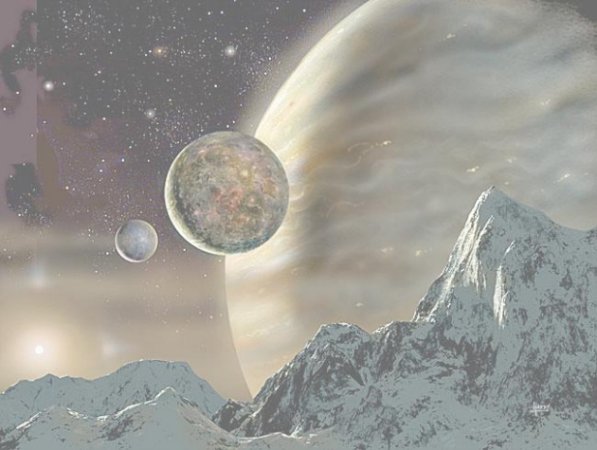 |
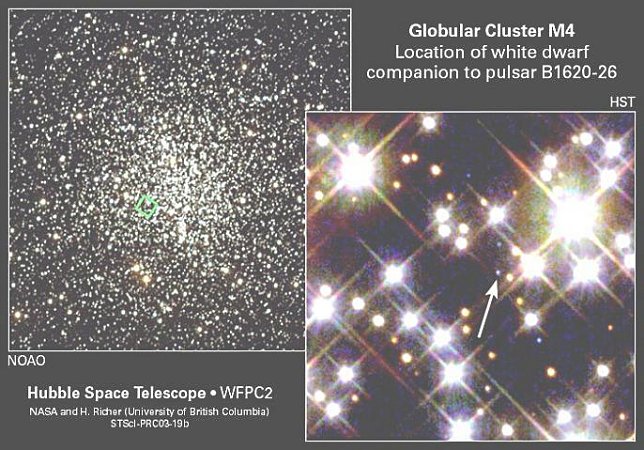 |
In the summer of 2003 astronomers have discovered a planetary system more similar to our own Solar System than any known previously. The bright star HD70642, visible with binoculars toward the constellation of Puppis about 90 light years away, was already known to be a star like our Sun. Now a planet with twice Jupiter's mass has been discovered in a nearly circular orbit at approximately |
Figure 07-26 Another World [view large image] |
Figure 07-27 Ancient World [view large image] |
Meanwhile it is discovered that a planet, a white dwarf, and a neutron star orbit each other in the giant globular star cluster M4, some 5,600 light-years away. The most visible member of the trio is the white dwarf star, indicated in an image from the Hubble Space Telescope (see Figure 07-27), while the neutron star is detected at radio frequencies as a pulsar. A third body was known to be present in the pulsar/white dwarf system and a detailed analysis of the Hubble data has indicated it is indeed a planet with about 2.5 times the mass of Jupiter. In such a system, the planet is likely to be about 13 billion years old. Compared to our solar system's tender 4.5 billion years and other identified planets of nearby stars, this truly ancient world is by far the oldest planet known, almost as old as the Universe itself. Its discovery as part of an evolved cosmic trio suggests that planet formation spans the age of the Universe and that this newly discovered planet is likely only one of many formed in the crowded environs of globular star clusters.